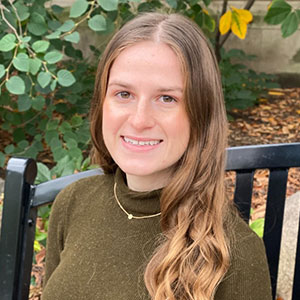Poster Sessions

Jasmine Anderson, BS
Genome-wide CRISPR screens identify PTGES3 as a druggable AR modulator
The androgen receptor (AR) is the central therapeutic target in advanced prostate cancer. While treatments that directly target AR are effective in prolonging patient survival, aggressive prostate cancers invariably find a way to evade these therapies. Eventually, evasion mechanisms reestablish AR expression and therefore AR-driven oncogenic pathways are restored. Comprehensively understanding the protein regulation machinery of AR and identifying alternative therapeutic targets are crucial for effective treatment of this disease.

Tomas Bencomo, BS
Spatial transcriptomics analysis of Merkel cell carcinoma reveals novel immune cell subsets and hypoxia as correlates of immunotherapy response
Immune checkpoint blockade remains the standard of care for advanced Merkel cell carcinoma (MCC); however, approximately 50% of patients develop either primary or acquired resistance. Although the tumor microenvironment (TME) is implicated in mediating therapeutic outcomes, the specific cell types involved, and the impact of their spatial organization remain largely undefined. To address this gap, we applied Xenium spatial transcriptomics to 27 treatment-naive MCC tumors from a clinical trial of retifanlimab in advanced MCC, with the goal of uncovering TME correlates of immunotherapy response.

Kate Carbone, PhD
Intratumoral cDC1-T Cell Clusters Serve as Sites of Local Costimulation to Enhance CTL-Mediated Tumor Rejection
T cells are essential for anti-tumor immunity, but their ability to eliminate tumors depends on coordinated interactions with type 1 conventional dendritic cells (cDC1s). While cDC1s are known for cross-presenting tumor-derived antigens in lymph nodes to prime CD8+ T cells, their role within the tumor itself remains less well understood. Here, we use the Skin Tumor Array by Micro-Poration (STAMP) model to investigate how cDC1-T cell interactions shape immune responses and influence tumor fate.

Shannon Dexter, MS
Improving outcomes in AML with anti-CD45 RIT with 211At in combination with venetoclax using murine leukemia models
Antigen-specific immunotherapies have long been pursued for acute myeloid leukemia (AML). Since AML cells are exquisitely radiosensitive across the entire genetic disease spectrum, anti-CD45 antibodies are ideal to arm with alpha-emitting radionuclides for radiation delivery, as standalone therapies and/or intensifying conditioning regimens, before hematopoietic cell transplantation (HCT). Unlike the beta-emitters previously used (i.e., yttrium-90, iodine-131), alpha-emitters deliver a high amount of radiation over a few cell diameters, enabling precise and efficient target cell death. We will use astatine-211 (211At) because of the shorter half-life, and its ability to decay without producing dangerous, long-lived daughter isotopes that are not retained by the target cells.

Francesca Gaerlan, BS
Improving haploidentical hematopoietic cell transplantation engraftment efficiency and reducing conditioning regimen toxicity
Allogeneic hematopoietic cell transplantation (HCT) is a curative treatment option for acute myeloid leukemia (AML) and often requires intensive chemotherapy and/or total body irradiation (TBI) for its preparative conditioning regimen. However, the conditioning regimen before HCT can be rather toxic due to adverse effects, leading to morbidity and even death. Although HCT outcomes have been improved through optimization of the conditioning regimen, HCT for ethnic minority groups is limited because HCT requires the use of complete human leukocyte antigen (HLA)-matched donors. Haploidentical HCT has made HCT more accessible, wherein the donor only needs to be partially HLA-matched.

Matthew Hathaway
Targeting CTPS1 and nucleotide metabolism as a therapeutic approach in MYC-amplified medulloblastoma
Medulloblastoma (MB) is the most common pediatric CNS malignancy comprising a biologically heterogeneous group of embryonal tumors of the cerebellum. MYC-amplified MB tumors are the deadliest of all subgroups with a <50% 5-year overall survival rate. High risk patients receive large doses of chemo- and radio- therapy (CT/RT) with most survivors experiencing debilitating neurological and cognitive sequelae making the identification of novel targets of the utmost importance. Utilizing data from the Pediatric Cancer Dependency Map, we identified the enzyme CTPS1 and others in the de novo pyrimidine biosynthesis pathway as possible cancer-specific vulnerabilities in MYC-amplified MB.

Christopher Kemp, PhD
Functional precision medicine profiling of patient-derived tumor organoids identifies effective targeted therapies for patients with low-grade serous ovarian carcinoma
We sought to determine whether functional precision medicine (FPM), which combines ex vivo drug testing of patient-derived organoids (PDOs) with genomic profiling, could identify effective therapies for patients with low-grade serous ovarian carcinomas (LGSOC). Fresh tumor tissue was obtained from 17 patients undergoing surgery or image-guided biopsy for LGSOC, 12 at recurrence and 5 at primary surgery. Short-term PDO cultures were derived and profiled for sensitivity to a broad panel of oncology drugs using the SEngine Precision Medicine PARIS test.

Kikkeri Naresh, MBBS, DCP, MD, FRCPath; Aarti Kanzaria, MD; Anisha Naik, MD, MPH; Evan Newell, PhD; Carolyn Shasha, PhD
Digital Pathology and AI-Based Analysis of P53 Biomarker in Lymphomas: Correlation with Genetic Data
TP53 mutations are a critical biomarker in hematolymphoid malignancies. P53 immunohistochemistry (IHC) is routinely used in clinical laboratories to rapidly screen tumor samples for TP53 gene mutations. Mutated P53 protein has a longer half-life compared to wild-type protein. We aimed to correlate P53 protein expression, as assessed by IHC, with TP53 alterations in lymphomas using digital algorithms. We describe a novel research method to assess TP53 expression and can serve as an adjunct to genomic studies.

Kikkeri Naresh, MBBS, DCP, MD, FRCPath; Aarti Kanzaria, MD; Anisha Naik, MD, MPH; Evan Newell, PhD; Carolyn Shasha, PhD
The impact of transcriptome on the grade of follicular lymphoma in a spatial context – Early Results from analysis on the 10X Xenium platform
Follicular lymphoma (FL), a germinal center-derived B-cell lymphoma affects 2.5 per 100,000 men and women per year in the United States. About 20% patients experience disease progression within 24 months of diagnosis. Our prior studies have demonstrated that high-grade FL (grade 3; HG-FL) is associated with a worse prognosis compared to low-grade FL (grade 1-2; LG-FL). However, the grading system for FL suffers from significant inter- and intra-observer variability. To address the need for improved biomarkers for FL grading and outcome prediction, which are crucial for optimal treatment strategies, we performed spatial transcriptomics and multiplex immunohistochemistry (m-IHC) on 22 FL samples.

Saisha Lakkoju, BS Candidate
A comprehensive transcriptomic landscape of prostate cancer for molecular subtyping and biomarker discovery
Prostate cancer exhibits substantial molecular and clinical heterogeneity, necessitating a comprehensive reference framework for improved characterization. We compiled 5 datasets of bulk RNA sequencing data from 1,313 primary and metastatic prostate tumors to establish a detailed transcriptomic landscape. After rigorous batch effect correction, normalization, and dimensionality reduction, we constructed a unified map to investigate gene expression patterns, signaling pathways, gene fusions, and copy number alterations.

Miranda Lyons-Cohen, PhD
Engineering fusion proteins to enhance efficacy of adoptive cell therapy for solid tumors
Adoptive cell therapy (ACT) is a “living drug” that provides the opportunity to genetically modify T cells to recognize and kill tumors. While this therapy has shown incredible curative potential in hematologic cancers, engineered immune cells can struggle to overcome immunosuppressive barriers in solid tumor microenvironments (TME), which has necessitated the development of novel engineering strategies. The TME presents obstacles that reduce T cell persistence and function, including hypoxia, upregulated inhibitory/death ligands, and immunosuppressive immune cells that promote tumor progression.

Anca Mihalis, PhD
Human transcription factors necessary and sufficient for maintaining glioblastoma tumor cell identity
Glioblastoma (GBM), the most aggressive grade IV brain tumor, has seen limited improvement in survival outcomes over decades, largely due to its extensive intratumoral heterogeneity, a key driver of therapeutic resistance. Unlike normal neurogenesis, where cells follow clear developmental hierarchies, GBM comprises diverse subpopulations resembling neurodevelopmental cell types with poorly understood relationships. Single-cell genomics has advanced GBM research but fall short in isolating, characterizing, and manipulating these subpopulations, representing a critical barrier to understanding tumor biology and developing effective therapies. Here we sought to develop new biological tools and functional genomic screening approaches, with which to better dissect GBM subpopulations.

Colm Morrissey, PhD
Chronicling Prostate Cancer Liver Metastasis
Patients with liver metastasis have a poor prognosis and liver metastasis have been associated with the emergence of neuroendocrine prostate cancer post androgen receptor (AR) pathway inhibitors (ARPIs), such as enzalutamide and abiraterone. Leveraging the prostate cancer rapid autopsy program at the University of Washington, we set out to determine (i) the prevalence of liver metastasis, (ii) when they occur in the disease history, (iii) if abiraterone treatment is effective in patients with liver metastasis, (iv) if the emergence of AR negative disease in castration-resistant prostate cancer is associated with liver metastasis, and (v) if there is a biological event that promotes liver metastasis in patients with castration-resistant prostate cancer.

Omkar Phadnis
A unified transcriptomic melanoma reference map for biological insight and prognostic prediction
Melanoma is amongst the most lethal types of skin cancer. Although advances like checkpoint immunotherapy have improved outcomes in recent years, only 40% of patients respond and it remains difficult to predict which patients will respond. Various studies have generated bulk RNA-seq datasets from patient melanoma samples; however, these datasets have never been combined to enable highly powered analyses and generalizable conclusions. In this study, we unified multiple published RNA-seq datasets to generate a reference landscape with over 1,000 melanoma samples. we represented the whole transcriptome for each sample using uniform manifold approximation and projection (UMAP), a dimensionality reduction technique.

Marc Radke
Clonal hematopoiesis in ovarian cancer survivors: Correlation with carboplatin and PARP inhibitor exposure
Ovarian cancer (OC) survivors may develop therapy-related myeloid neoplasia (TMN), and the risk is higher after treatment with PARP inhibitors (PARPi). We characterized clonal hematopoiesis (CH), which may pre-date TMN, in blood from OC survivors, and its relationship to therapeutic exposures.

Nicole Rhoads, BS
Progress toward development of function blocking antibody against angiopoietin-like 7 to prevent necrosis and metastasis
Necrosis is uncontrolled cell death caused by environmental changes like hypoxia and it has recently been associated with tumor dissemination, metastasis, and treatment resistance. Angiopoietin-like 7 (Angptl7) is secreted by perinecrotic tumor cells and regulates the formation of necrosis and metastatic dissemination. When Angptl7 is suppressed in vivo, necrosis and metastasis decrease1. We are developing antibodies that bind Angptl7 and investigating the effect of lead candidates on tumor growth dynamics and necrosis.

Sihyeon Song
Deciphering the role of mRNA translation in development and oncogenic cell fate decisions
Our objective is to identify RNA Binding Proteins (RBPs) that translationally control cell fate regulators during development and oncogenic activation.

Suleeporn Sujichantarat, PhD
Deep learning to synthesize dynamic contrast-enhanced breast MRI from non-contrast images for monitoring response to treatment
Conventional dynamic contrast-enhanced (DCE) MRI relies on gadolinium-based contrast agents (GBCAs) and reflect abnormal tissue vascularity, aiding physicians in identifying cancers. However, GBCAs may cause side effects in some patients and repeated doses used in screening and treatment monitoring can result in small amounts retained in the body, posing additional unknown health risks. Furthermore, administration of GBCAs is costly and time consuming, which makes MRI exams overall less accessible. To eliminate the need for GBCAs and improve the safety and accessibility of breast MRI, prior work has successfully utilized Artificial Intelligence (AI), specifically deep learning models, to synthesize DCE images from a variety of different non-contrast MR images. In this work, we aim to apply a deep learning model to synthesize DCE-MRI of invasive breast cancers and monitor treatment response in patients undergoing neoadjuvant chemotherapy (NAC).

Ramya Suresh
Transcriptomic Analysis Identifies Distinct Pathways, Copy Number, and Fusions in TNBCs
To better understand the molecular landscape of breast cancer subtypes, we integrated RNA-Sequencing data from 6 breast cancer datasets totaling to 1413 samples and applied Uniform Manifold Approximation and Projection (UMAP) to develop a Breast-UMAP. This visualization tool overlays genetic and clinical information, including gene expression and race, to reveal subtype-specific differences. Triple negative breast cancer (TNBC) clusters distinctly from ER+, PR+, and HER2 subtypes, and the latter cloud displays notable patterns in ESR1 and AR expression. Additional regions have been identified with high expression of PDCD1 and CD8A, suggesting a positive response to checkpoint inhibitors. Our landscape serves as a vital resource for identifying biomarkers and enables the mapping of new patients’ bulk RNA-seq data to facilitate accurate disease subtype identification. The landscape is accessible via Oncoscape, an interactive platform, empowering global exploration and application.

Wesley Surento, MS
Quantitative Background Parenchymal Enhancement Metrics from MRI as Risk Markers for Future Breast Cancer in Younger Women
Breast cancer is the most common cancer worldwide and second highest cause of cancer-related death among women in the United States. Early detection can save lives, but better breast cancer risk prediction models are needed to optimize surveillance strategies, particularly in younger women. Background parenchymal enhancement (BPE), an imaging marker qualitatively assessed by radiologists on screening breast MRI has shown promising association with breast cancer risk, where higher BPE is associated with higher risk of future breast cancer. In this study, we sought to evaluate the relative performance of quantitative BPE metrics to predict future breast cancer in women under 50 years of age by incorporating clinical risk scores and imaging features into support vector machine (SVM) classifier models to predict 5-year risk.

Laavan Suresh
Visualizing the genetic landscape of lung cancer with 1669 patient and PDX samples
In order to understand the molecular landscape of lung cancer, we obtained RNA-sequencing data from 18 datasets containing patient samples (and some PDX) totaling to a variety of lung cancer sub-classifications: adenocarcinoma, squamous cell carcinoma, and small cell lung cancer. Non-small cell lung cancer and small cell lung cancer contained 1415 and 254 samples respectively. A Uniform Manifold Approximation and Projection (UMAP) dimension reduction function was applied to gene expression data extracted from these datasets which were also rigorously corrected for batch effects.

Isabella Terrones, BS
Prevalence of the metabolic syndrome, adiposity and individual metabolic biomarkers in childhood brain tumor survivors
Our objective is to determine the prevalence of the metabolic syndrome, adiposity and abnormalities in individual metabolic biomarkers in childhood brain tumor (CBT) patients after treatment and compare CBT patient data values to population norms.

Rasika Venkataraman, PhD
Dissecting the mechanisms of DDX41 mutations in the pathogenesis of myeloid leukemia
Germline mutations in the RNA helicase DDX41 are the most common genetic predisposition to myelodysplastic syndromes (MDS) and acute myeloid leukemia (AML), representing 5-7% of AML. Patients with germline heterozygous mutations in DDX41 present with clinical symptoms of cytopenia and myeloid malignancies at a median age of 70 years. Approximately 60% of these patients acquire a somatic missense mutation at specific hotspots in the helicase domain (pR525H or pG530D) of DDX41 in trans, which is associated with progression to AML. While intensive chemotherapy and bone marrow transplants have shown promise in treatment of DDX41-associated myeloid malignancies, age-related complications and donor-related germline disposition can complicate treatment.

Julia Walker
What does good look like for a kinase inhibitor?
Anaplastic lymphoma kinase (ALK) gene fusions have been identified as drivers of gliomas, with an enrichment in infant and pediatric-type cases. However, 1st-generation targeted inhibitors of ALK-rearranged tumors (such as Crizotinib) often have short-lived benefits. Lorlatinib, a third generation ALK inhibitor developed to overcome resistance to Crizotinib, has been shown to be superior to Crizotinib for the treatment of ALK-driven NSCLC with brain metastases, although the efficacy of Crizotinib and Lorlatinib against ALK fusion-driven gliomas has not been compared in a controlled system. We used the RCAS/tv-a system to develop genetically engineered mouse models of ALK fusion-driven pediatric-type gliomas and treated them to evaluate the efficacy and impact on survival and tumor volume of ALK inhibitor treatments at different timepoints. Treatment of mice harboring ALK fusion-driven pediatric-type gliomas showed that Lorlatinib has a significantly higher efficacy in inhibiting tumor growth compared to Crizotinib. We also found that when Lorlatinib treatment is stopped after six weeks, tumor growth is held in check for at least 1-4 weeks, with preliminary evidence suggesting a shift to a state where the tumors stop responding to the ALK fusion.

Dave Young
tRNA dosage regulates lineage plasticity and therapy resistance in prostate cancer
Prostate cancer is the second most common malignancy in the United States in men. Early-stage prostate cancer is androgen-dependent and relies on the androgen receptor (AR) signaling pathway for growth and proliferation. Following androgen deprivation therapy (ADT) and AR signaling inhibitors (ARSIs), the disease becomes refractory to AR-targeted therapies through a process known as phenotype switching. In prostate cancer, protein components of the translation apparatus have been shown to promote disease progression and even drug resistance. However, it remains elusive how prostate cancer utilizes RNA components of the protein synthesis machinery to support lineage plasticity and drug resistance. This represents a significant blind spot in our understanding of prostate cancer pathophysiology and an unmet need that has the potential to identify new biomarkers and therapeutic targets.

Ming Yu, PhD
Spatial transcriptomics analysis of human colon adenomas reveals distinct features of precancer microenvironment associated with tumor progression
Colon adenomas are considered the precursor of the majority of colorectal cancer, a major cause of cancer related morbidity and mortality. While many studies of adenoma progression have extensively characterized the molecular and cellular alterations in colon epithelial cells, much less is known about the contribution of the tissue microenvironment during adenoma initiation and progression. The emergence of spatially resolved transcriptomics technologies has allowed unprecedented opportunities to uncover the complex transcriptional profile of heterogeneous tissues in situ and enabled investigation of the complex interactions between epithelia, stroma, and immune microenvironment at high resolution.

Rachael Zemek
What Does Surgery do to Cancer? How the Surgical Wound Healing Response can be Leveraged to Improve Immune Checkpoint Therapy and Eradicate Residual Disease.
Surgical removal is critical in treating solid cancers, however cancer relapse at the surgical site remains a major cause of poor outcomes. It is currently not understood how the wound healing response from surgery impacts cancer growth and the local immune environment, which may alter the response to treatments. As surgery initiates a local immune response, we hypothesized it may alter the response to immune checkpoint therapy (ICT). By exploring the dynamics of the immune response following oncological surgery and its interaction with ICT, we may exploit the combination by optimally scheduling these treatments to eliminate residual disease and prevent relapse.